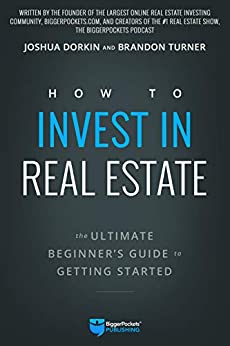How to Invest in Real Estate: The Ultimate Beginner’s Guide to Getting Started is written by Josh Dorkin and Brandon Turner.

Josh and Brandon are both experienced real estate investors and longtime hosts of The BiggerPockets Podcast, the world’s #1 real estate podcast.
One of the most unique things about their book is that it doesn’t pretend to offer a one-size-fits-all path to real estate investing success. Instead, the authors explore the various real estate niches and strategies real investors use to help you pick the approach that’s right for you.
Key Takeaways / Lessons Learned
How to Invest in Real Estate: The Ultimate Beginner’s Guide to Getting Started gives a general overview of the most important factors that can affect your success as a real estate investor.
Understanding your motivations
The book begins by asking two important questions:
- Why real estate investing?
- How do I get started with real estate?
In this review, we’ve rearranged the order of the questions as they’re presented in the book. That’s because it’s important to understand “why” you’re doing something first, before you ask “how” to do it.
The “why” of real estate investing
The fact is that investing in real estate isn’t the right choice for everyone.
Even passive real estate investing takes a certain amount of education, research, and work. And while it’s quite possible to begin investing in real estate with just a few thousand dollars, some people are more comfortable taking the path of least resistance. They invest in stocks and bonds, accepting average returns and stock market volatility.
However, because you’re reading this review, our guess is you’re one of those people who understands “why” real estate investing makes good sense.
Everyone has their personal reasons for investing, and How to Invest in Real Estate: The Ultimate Beginner’s Guide to Getting Started lists some of the most common motivations for getting started in real estate:
- Building wealth through passive income
- Real estate investing can be done without a lot of money
- Easy to start small and scale up
- Create a better life for yourself and your family now, and in the future
Those are just a few of the reasons why people invest in real estate, and no doubt you may have several reasons of your own. That’s one of the many things that makes real estate investing so great: anyone – regardless of personality, financial position, or location – can invest in real estate.
The “how” of real estate investing
Now, let’s discuss the “how” of getting started in real estate. There are actually two questions to answer when choosing your “how”:
1) Which type of real estate to invest in
2) Which investment strategy to use
One of the challenges beginning real estate investors face is that there’s so much to choose from. That’s why the asset class of real estate is often compared to a box of chocolates. You know that each piece is going to be delicious, you’re just not sure which one to take a bit of first.
For example, basic real estate asset classes include:
- Land
- Office
- Retail
- Industrial
- Residential
Within each asset class, there can also be a wide variety of sub-classes or categories. Let’s use residential as an example:
- Single-family houses
- Condominiums or cooperatives
- Small multifamily (2 to 4 units)
- Midrange multifamily (up to 12 units)
- Large apartment buildings
- Mixed-use projects that include residential
One of the biggest reasons many real estate investors choose to buy single-family rental houses is because that’s the asset type they’re most familiar with.
Compared to other options, houses are also easy to mortgage, leasing and property management generally takes less time and effort, and analyzing the potential financial value of single-family rental houses is simplified when you use the Roofstock Investment Property Marketplace.
Once you’ve selected the type of real estate you’re going to invest in, you also need to decide on an investment strategy. Single-family rental houses are best for the investor with a long-term, buy-and-hold strategy.
That’s because the benefits of recurring cash flow, appreciation over the long term, and tax benefits such as deduction of normal business expenses and the tax-sheltering effect of depreciation as magnified. The longer you hold the house, the more potential benefits you’ll receive.
Other common investment strategies include fixing-and-flipping and wholesaling. Both of these alternatives to buying-and-holding take a lot of time and effort, involve a higher level of risk, and aren’t eligible for much of the favorable tax benefits that real estate investors receive when buying property for a long-term hold.

Chapter/Section Summaries
With nine chapters written in a reader-friendly manner, it’s easy to finish How to Invest in Real Estate: The Ultimate Beginner’s Guide to Getting Started in one weekend:
- Nine Questions Every Real Estate Beginner Wants Answered
- Boring Financial Stuff – That Just Might Save Your Life
- Getting Your Ducks in a Row
- Real Estate Investment Niches
- Real Estate Investment Strategies
- 27 Ways to Find Incredible Real Estate Deals
- 12 Ways to Finance Your Real Estate Deals
- Real Estate Exit Strategies
- How to Work (FAR) Less and Get (WAY) More Done
There’s a lot of useful information in the book. Here’s an in-depth look at a few of the most interesting chapters.
Getting Your Ducks in a Row
“Give me six hours to chop down a tree and I will spend the first four sharpening the axe.” – Abraham Lincoln
Chapter 3 of How to Invest in Real Estate: The Ultimate Beginner’s Guide to Getting Started begins with this quote from the 16th president of the United States. It’s a perfect description of the dilemma that many beginning real estate investors face: Over analysis paralysis.
The #1 reason why investors analyze too much is because they’re nervous. The book recommends several ways to overcome the paralysis that results from fear:
- Get Off Your Duff: Develop an action plan that includes small, achievable steps that lead you to your ultimate goal, or the reason why you’re investing in real estate.
- Commit: Convince yourself that real estate investing is something you and your family really want to do before wasting your time and money on seminars, books, and training programs. Once you’re truly committed, you’ll find success as a real estate investor.
- Start Participating: Attend regular meetings of the real estate investor groups in your area, read online blogs and ask questions to learn from people with more experience than you have, or take a lender to lunch to learn about different loan programs and resources.
- Learn the Lingo and Concepts: There’s jargon in almost every industry, and real estate is no exception. When you understand what items such as cap rate, cash-on-cash, ROI, and IRR mean and what they’re used for, you’ll be much more confident and find it easier to interact with other real estate professionals.
The third chapter of How to Invest in Real Estate: The Ultimate Beginner’s Guide to Getting Started also touches on the reality of real estate market cycles. Most people have heard of buyer’s markets and seller’s markets.
A buyer’s market is when the number of houses on the market exceeds the demand, so sellers become more motivated, lower asking prices, and offer more concessions to make their property more attractive to buyers that are few and far between.
On the other hand, in a seller’s market the seller is in control. Demand for houses from owner-occupants and investors is so strong that bidding wars often ensue, with sellers receiving multiple offers well above their asking price.
However, what many people don’t understand is that real estate market cycles are normal and relatively predictable. As far back as the early 1800s, researchers discovered that real estate cycles historically run an 18-year rhythm, from the bottom of the cycle to the top.
The Harvard Extension School reports that for over 200 years, real estate markets have followed four phases:
- Recovery where real estate prices are at their lowest point in the cycle
- Expansion where demand begins to exceed available supply and landlords can begin raising rents again
- Hyper supply from developers building more property due to very high demand and extremely strong rent growth
- Recession due to an oversupply of housing, which drives occupancy rates and rents lower, causing declining profits for real estate investors
As the saying goes, “Knowledge is power.” By understanding each phase of the real estate market cycles, investors can actually profit from the fear of others by adjusting their investment tactics and strategies to adapt to the realities of the marketplace.
Real Estate Investment Niches: Single-Family Houses
Chapter 4 of How to Invest in Real Estate: The Ultimate Beginner’s Guide to Getting Started takes an in-depth look at the various types of real estate investment niches.
Single-family houses are the most common investment for most first-time – and experienced – real estate investors because they’re easy to rent, easy to sell, and easy to finance.
The book lists several benefits of investing in single-family rental property including:
High-inventory: Single-family homes are literally everywhere, so they’re easy to find. People also prefer to live in houses rather than condos or apartments, especially in the U.S. Tenants view a single-family home as the “top of the real estate food chain”. So, given the choice, renting a house is much more attractive to a renter than having to live in a cramped apartment.
Easier to sell and rent: There’s more perceived value from tenants renting a single-family house, so they’ll usually rent faster and for a higher rent than a multifamily unit will. When the time comes to sell, investors can sell their rental property to an owner-occupant, or another investor looking for a cash flowing property with a tenant already in place.
Financing is simple: In addition to investors and tenants understanding single-family houses, banks also like to make loans for homes. There are plenty of loan programs and options available for investors, including FHA, VA, conventional, portfolio mortgages, private money, and joint venture financing.
Cash flow and appreciation: When purchased properly and held for the long term, investors can earn recurring monthly cash flow plus appreciation in market value that outpaces the rate of inflation. In a surprisingly short period of time, it’s possible to use a cash-out refinance to turn accrued equity into money. Those funds can then be used to generate even more revenue, such as adding value in an existing property to increase rents or scaling up an investment portfolio by purchasing more rental property.
Simple to manage: Everyone understands how a single-family home “works”, so they’re much easier to manage than a multifamily property with more units and potential tenant problems. Plus, generally speaking, tenants renting single-family houses are “higher caliber”, so they tend to take care of the property better, pay their rent on time, and renew their lease more often.

Real Estate Investment Strategies
There are 10 real estate investment strategies discussed in Chapter 5 of How to Invest in Real Estate: The Ultimate Beginner’s Guide to Getting Started:
- Buy and hold
- House flipping
- Wholesaling real estate
- Real estate development
- Turnkey investing
- House hacking
- Short-term (vacation) rentals
- Live-in house flips
- BRRR investing (rehabbing, renting to tenants, refinancing, and repeating)
- Student rentals
Let’s take a closer look at two of the real estate investment strategies outlined in the book:
Buy and HoldThe most common form of real estate investing strategy involves buying a house, renting it out, keeping it maintained, and holding onto it for an extended period of time.
While this strategy can be used with any real estate asset class – such as farmland, single-family and multifamily property, office and retail buildings, and industrial property – it’s usually the investment strategy of choice for single-family houses. That’s because people prefer to live in a house vs. an apartment, and they generally take care of the property better.
Using the buy and hold strategy to invest in single-family houses can create predictable cash flow that pays for operating expenses and paying down the mortgage faster, appreciation and a build-up of equity over the long term, and tax benefits such as depreciation that can be used to “shelter” income and reduce the amount of taxes owed.
Turnkey InvestingTurnkey real estate is property that is “rent-ready”, with all needed repairs and updating done, and is usually already rented out to a tenant. Investing in turnkey single-family homes is perfect for people looking for passive income and for long-distance real estate investing.
Because turnkey houses are already occupied, positive cash flow for the investor begins the day escrow closes. Although the concept of turnkey investing has been around for some time, the popularity of buying turnkey investment real estate has taken off over the last few years for a couple of reasons.
First, more and more people are realizing that single-family rental property can be a much better investment than traditional stocks, mutual funds, or government bonds that pay next to nothing in interest.
In fact, Business Wire recently reported that since debuting in 2016, Roofstock has surpassed $2 billion in transaction value in the $4 trillion single-family rental home sector. The article notes that Roofstock’s momentum underscores the enormous pent-up demand from investors, while the firm leverages technology to help make investing in single-family houses almost as easy as buying stocks.
The second reason that turnkey investing is becoming so popular is that the strategy is a perfect match for long-distance real estate investing.
As odd as it may seem, some of the wealthiest real estate investors live in places where they don’t invest. In coastal markets such as Los Angeles, San Francisco, New York, and Boston, the high cost of living combined with the high price of housing make it difficult to find rental property that makes good investment sense.
In smaller, secondary markets such as Austin, Nashville, and Charlotte, rental property can be much less expensive to purchase, while cap rates, cash-on-cash returns, and yields are much higher.
One of the keys to successfully investing in turnkey rental property long distance is to have an experienced local real estate team. Hiring property managers in the local market let investors focus on the big picture while the manager handles the daily details to make sure the house is well maintained and cash flowing.

Real Estate Exit Strategies
Chapter 8 of How to Invest in Real Estate: The Ultimate Beginner’s Guide to Getting Started appears toward the end of the book, but many experienced real estate investors might say it should be at the beginning.
That’s because it’s critical to know what your end game – or exit strategy – is before you begin your real estate investing journey. And the authors of the book seem to agree, saying that “Choosing the best strategy for existing your real estate investment is just as important as deciding which one to buy.”
There are various exit strategies investors use throughout their careers:
Traditional selling with a real estate agent
The 80/20 rule holds true when selecting a real estate agent. Because 20% of the agents out there sell 80% of the listings on the MLS, it’s important to find a real estate agent who actually does what they promise to do.
After signing a listing agreement with a real estate agent, a seller should expect the agent to list the property on the MLS, market and advertise the property online and offline, show the house to qualified prospective buyers, handle all of the paperwork, and manage negotiations and the entire transaction until the deal closes.
Selling FSBO or “For Sale by Owner”
The largest number of FSBOs appears when the real estate market is at its peak or at its bottom.
When the market is red hot, homeowners decide to save money by not paying a real estate agent commission and selling the home on their own. In a seller’s market, where multiple offers above the asking price are the norm, who can blame them?
There is also a lot of for sale by owner property when a local real estate market begins to bottom out, but for the opposite reasons. In a buyer’s market, many homeowners may be upside down with negative equity. It’s not that they don’t want to list their property with a real estate agent, it’s simply that they can’t afford to pay the real estate commission.
Astute single-family real estate investors can potentially profit from these motivated sellers by buying good rental property at a below market rate.
Selling using seller financing
Seller financing – also known as a land contract or seller carryback – offers a way to purchase or sell real estate without going to a lender. Sellers who own their property free and clear, without any mortgage or other liens, often offer to act as the bank for a qualified buyer.
The buyer and seller draw up a purchase and financing agreement, and after doing the due diligence the buyer makes a down payment to the seller, closes escrow, and makes monthly payments to the seller at the agreed to terms and interest rate.
It’s always a good idea to have an independent third party – such as an escrow company or attorney - who accepts, tracks, and distributes the monthly mortgage payment. That way, payments are applied properly, and the outstanding loan balance is always accurate and up to date.
There are several reasons a seller would offer financing instead of accepting all cash up front:
- Property may be difficult to sell due to a slow market
- Property has a significant amount of deferred maintenance, making it difficult for a buyer to get a loan
- Buyer unable to qualify for a loan due to high interest rates, self-employment with a high level of cash income, or a damaged credit report
- Seller prefers to receive a mortgage payment – and collect interest income - from the buyer to minimize the amount of capital gain tax owed or for estate planning purposes
1031 exchange
Another popular exit strategy for real estate investors is the 1031 tax deferred exchange. When a real estate investor sells an investment property and buys another, the IRS allows the investor to defer the payment of any capital gains tax that would normally be due on the profit made from the sale of the property.
There are specific rules and timelines investors must follow when conducting a 1031 exchange, but fortunately there are companies who act as 1031 intermediaries to ensure the IRS rules are followed and the tax deferred exchange is done correctly.
In addition to deferring taxes, a 1031 is a good exit strategy for:
- Transitioning from one asset class to another, such as selling an office building and purchasing a portfolio of single-family rental houses
- Geographically diversifying a property portfolio by selling houses that are all in the same market and buying property in lower-priced markets with better yields and higher cash flow
- Selling a large multifamily to an institutional investor, then buying several single-family rental houses from mom-and-pop sellers
Is the Book Worth Reading?
Strong points of the book
- Ultimate beginner’s guide for people who know they want to get started investing in real estate but aren’t sure where to begin.
- Plenty of actionable information written by two authors who are actively involved in real estate investing.
- Easy to read and understand without having to wade through industry jargon.
Weak points of the book
- Some readers may consider the book too basic and more of a motivational book without a lot of detailed guidance for real estate investing.
- Much of the information in the book can easily be found online for free.
- BiggerPockets Podcasts are referenced throughout, at times making the book feel more like an advertising vehicle and an educational tool.









